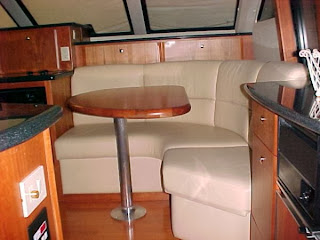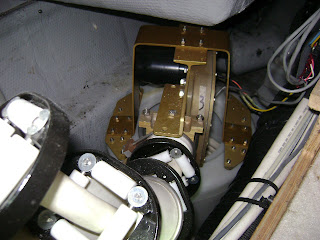One thing Silverton didn't skimp on when building our 453MY was entertainment. The boat came with 5 TV's - one in each of the three staterooms, one in the saloon and one on the sundeck. All but the one on the sundeck had a DVD player, and two of those included VCR recorders as well. The salon TV was connected to a Bose surround sound system (which also contained a DVD/CD player and AM/FM radio, and their were another 2 stereo AM/FM radios....one on the flybridge and one in the master stateroom (which also had a CD stacker). All the TV's were analogue units and all but one were Cathode Ray Tube (CRT) type. However, in the time between our purchase of Loopy Kiwi and the start of the Loop, the USA had gone to digital broadcasting of TV, so they would only work when connected to a cable network (which many of the marinas did not provide). We solved this issue by purchasing a digital to analogue convertor box from Walmart for around $50 and generally could access "free to air" TV broadcasts in most towns and many anchorages. The most I recall we got was 48 around the Chicago area, but also remember distinctly getting 16 channels at Cumberland Towhead anchorage, which seemed to be the middle of nowhere! Unless we were at a marina with cable, it limited us to only using the TV in the salon, but was better than nothing.
Fast forward to Loopy Kiwi arriving in New Zealand and let's start with the radios first.
When we reached Auckland I noticed that none of the radios could find any more than 2 stations...88.3 and 107.3... and, believe me, there are a lot more radio stations in Auckland than that! On top of that, the Bose surround system would not respond in any way to its wireless remote control, and without it, you can do nothing. I replaced the batteries several times to no avail and poured through the Bose manuals but found no reason why it would work in the US and not New Zealand. Finally, I contacted a Bose dealer for advice, who tested the remote and found it was simply dead. Despite the fact that the model of remote was obsolete and also peculiar to the Americas, Bose Australia had 3 of them in stock and $98 and three days later we were back in business.
By this time, I had been trying to find why the radios could not find any stations. If I manually tuned them, I could find my favourite station "Sound FM" (93.8Mhz), but only as 93.7 or 93.9, where they were audible, but obviously "off station". What I realized was that the radios were changing in 0.2 increments and since they started with odd numbers, they were only ever going to get odd numbers. Most of the stations in Auckland (and probably New Zealand) are even numbers in their frequencies...ie 89.4, 97.4, 93.8 etc. Again I consulted the manuals and could find no obvious way of changing this, and began to think that the radios were only suitable for operation in the USA - which is strange as they are both Sony from Japan. Finally I found a reference in the specification that stated the frequency range was switchable between 200kHz and 50kHz, but nothing under the installation or operating instructions on how to do it. On about the 20th re-reading of the manual I noticed a reference on the front panel diagram to a "frequency band switch....not shown" which was located on the bottom of the case and required removal of the radio to change. This was duly done and, after resetting the radio, we had frequencies that changed in 0.05 increments, and I had my radio stations. The Bose suffered from the same disease, but with the new remote control it was a simple programming change to make it get the right frequencies.
Next were the TV's and Videos.
The USA TV system is NTSC. The New Zealand system is PAL. The two are not compatible - you cannot watch a PAL broadcast on an NTSC receiver and vice versa. Some PAL VCR's will have an NTSC playback, but none of those on Loopy Kiwi have a PAL playback, except the Bose system - and I shall come back to that. New Zealand is presently still broadcasting an analogue signal, but that changes to digital on the 1st December this year. I had hoped the converter from Walmart would be able to use the NZ digital signal and supply the salon TV....but nope, not a show. I thought "well, I can replace the salon TV with one surplus from our home and the rest will be OK, at least as DVD players". So we took some DVD's from home and tried them in the players - including the Bose with the PAL playback. "Incorrect Zone" was the message on the screen, so the DVD players will only play Zone 1 DVD's (we are zone 4) and we only have 6 zone 1 DVD's that we bought in the USA. This makes all the TV's, DVD and VCR players on the boat totally useless. The other issue is that, while we have 230V shore power, when we are at sea all power is 115V, off the inverter or genset. So any replacement equipment need to be 115V. Fortunately, the leftover TV I was contemplating using was a 110-240V 50-60Hz model with a flat screen. I also discovered I had a spare DVD player that was also this voltage range, and furthermore most of the converters here (known as "freeview boxes" - we still need one for this TV) are the dual voltage as well. So, armed with all the above, plus cables and fittings galore we set up the boat with this system which works fine. Once tested, I decided to install it properly, which meant removing the old 30" CRT unit.

After a struggle to get it out of the cabinet (it weighed a ton!), I managed to get it up through the saloon door but realized that it wasn't going to fit through the sundeck door to the dock. It could be taken via the flybridge to the forward deck and over the side, but that would be a two man job and very difficult. In the end I got out the tools and pulled it to bits, removing all the case and PCB's to take it down to the bare cathode ray tube. This fitted through the back door with 5mm (1/4") to spare.
A fellow boatie from the marina is moving his boat up to the Philippines soon. Apparently there they work on the same system and voltages as the USA, so I will be donating the rest of the equipment to him, rather than throw it all in the rubbish skip.
One other interesting thing is that the USA zone 1 DVD's all work on the NZ zone 4 player that is now in the boat - so we don't have to throw away the 6 DVD's we bought in the USA!
Last weekend was Labour weekend here and we went for an extended cruise with Lyn and Lois, who would have joined us on the Loop earlier this year had things gone according to plan. Unfortunately I forgot to take my camera, so I am waiting for Lyn to send me her pix of the trip so I can do a posting for it.
Until then, take care y'all

























































